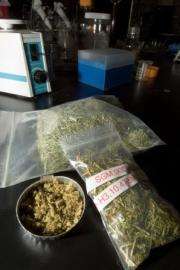Fermenting fodder into fuel

(PhysOrg.com) -- As climate change challenges continue to crop up around fossil fuel use and greenhouse gas emissions such as carbon dioxide, identifying renewable fuel materials and developing processes that produce environmentally friendly, cost-competitive biofuels are becoming increasingly important.
MSU scientists are at the forefront of biofuels research and have made Michigan a leader in producing biofuels from cellulose and hemicellulose, the complex sugars that make grasses, plant stems and stalks, and leaves rigid.
Unlike simple sugars or even starches in the grains of plants, such as corn kernels, cellulose doesn’t dissolve in water. This is good for keeping plants healthy, but it's a problem for making biofuels. Before the complex sugars in cellulose and hemicellulose (from woody plants) can be converted into ethanol or other biofuels, they have to be broken down into simple sugars. Because the process is difficult to do efficiently, it can significantly raise production costs. This is part of the reason why cellulosic biofuels aren't available commercially. Yet.
Bruce Dale, MAES chemical engineer and associate director of the MSU Office of Biobased Technologies is studying ways to use agricultural waste - the plant debris left after crops are harvested - as raw material for biofuels.
We can produce ethanol and other transportation fuels from cellulosic materials," Dale said, who has more than 30 years’ experience in studying pretreatments to make cellulose easier to break down. "There are some studies that show we can produce cellulosic ethanol for about $1 per gallon when the technology is fully mature. We're not there yet, but I believe we should be able to get cellulosic biofuels to the pump for about $2 per gallon in the relatively near future."
Dale has developed a process, ammonia fiber expansion, to pretreat cellulosic biomass with ammonia. MSU has received several patents on the process.
“The AFEX process makes the breakdown of cellulose and hemicellulose more efficient,” Dale said. “Using enzymes alone, about 15 percent of cellulose and hemicellulose is broken down into simple sugars; when AFEX is used before adding the enzymes, more than 90 percent of the cellulose and hemicellulose is broken down into fermentable sugars.”
The AFEX pretreatment process also increases the value of some cellulosic materials for other uses, such as feed for dairy and beef cows. Dale is collaborating with MAES animal scientist Michael Allen to evaluate the feed potential of several types of pretreated cellulosic plant materials.
Cellulosic materials that have been treated with the AFEX process are also easier and less expensive than raw, untreated materials to turn into pellets. Combined with regional biomass processing centers, pretreatment and pelletizing could solve a major logistical issue in the cellulosic biofuels industry.
"Because cellulosic materials are bulky, it's expensive to ship them very far," Dale said. "Getting enough of these materials together in one place is a challenge that the regional biomass processing centers would address. If we 'densify' the cellulosic materials into pellets, it's likely that the traditional corn grain handling equipment will work to load and unload the materials, further simplifying the logistical and transport issues."
Dale sees the processing centers producing not only the processed biomass that will go to biorefineries but eventually byproducts, biobyproducts if you will, including fertilizers, animal feeds, enzymes for the biorefining industry, and perhaps nutraceutical products for use by other industries.
In addition to the progress being made with biomass processes and logistics, Michigan State is partnering with Michigan Technological University to provide research support to the Massachusetts-based Mascoma Corporation as the company works to build one of the nation’s first cellulosic ethanol plants in Chippewa County in the Upper Peninsula of Michigan.
"The biomass supply chain is very important to creating a stable cellulosic biofuel industry and a stable bioeconomy for Michigan," Dale said. "This is an area that hasn't received a lot of attention, and it is one we are trying to address in our work."
Provided by Michigan State University















